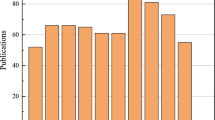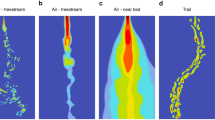Summary
-
1.
In adult locusts' wing opening for flight occurs soon after a jump is triggered. Previous studies have shown that the interval between the triggering of a jump and the initial wing movement (or the start of elevator muscle activity) is often too short for either the loss of tarsal contact with the ground or the self-generated air stream on the head to be responsible for the onset of wing opening. Thus it has been postulated that the system generating the motor program for the jump is directly linked to the system generating flight motor activity. To investigate this proposal we have recorded activity in flight motoneurons and interneurons during bilateral kicks of the hindlegs.
-
2.
The preparation was arranged to allow intracellular recording from flight motoneurons and interneurons during hindleg kicks. Kicks were readily evoked by mechanical stimulation of the abdomen, and the motor activity associated with the kicks was similar to that for a jump in unrestrained animals.
-
3.
Short sequences of flight activity were often associated with hindleg kicks. The time of onset of flight activity relative to the time kicks were triggered was variable, and often flight activity commencedbefore the kicks were triggered. The probability of flight activity being initiated increased throughout the co-contraction phase with the peak probability being close to the time kicks were triggered. Thus it appears that the flight system receives a progressively increasing excitatory input during the co-contraction phase of the kick, and that the onset of flight activity isnot tightly linked to the system triggering the kick.
-
4.
Intracellular recordings from flight motoneurons showed that wing elevator motoneurons often received an excitatory input during the co-contraction phase, whereas wing depressor motoneurons either showed no change in membrane potential or were slightly hyperpolarized during co-contraction. These recordings failed to reveal any significant input to flight motoneurons at the time a kick was triggered.
-
5.
The lack of any influence of the trigger system on the flight system was also apparent in recordings from identified flight interneurons. None consistently showed a synaptic response timelocked to triggering but many received synaptic input during the co-contraction phase. Those receiving excitatory input were also those excited by wind on the head, while those receiving inhibitory input were hyperpolarized by wind on the head.
-
6.
We conclude that the flight system receives an excitatory input during the co-contraction phase of the kick, and that this input produces many of the same changes in membrane potential in interneurons and motoneurons as does a wind stream to the head (a stimulus known to readily evoke flight activity). None of our data indicates that the system triggering the kick is responsible for exciting the flight system. We propose that in an intact animal the initiation of flight activity following a jump is facilitated by an excitatory input to the flight system during the co-contraction phase of the jump. The origin of this input has not been determined.
Similar content being viewed by others
References
Camhi JM (1969) Locust wind receptors. III. Contribution to flight initiation and lift control. J Exp Biol 50:363–374
Gynther IC, Pearson KG (1985) Intracellular recordings from interneurones and motoneurones during bilateral kicks in the locust: implications for mechanisms controlling the jump. J Exp Biol (in press)
Hedwig B, Pearson KG (1984) Patterns of synaptic input to identified flight motoneurons in the locust. J Comp Physiol A 154:745–760
Heitler WJ, Burrows M (1977) The locust jump. II. Neural circuits of the motor programme. J Exp Biol 66:221–242
Heukamp P (1984) Sensory regulation of the pleuroalar muscles in the migratory locust. Naturwissenschaften 71: 481–482
Pearson KG, Heitler WJ, Steeves JD (1980) Triggering of the locust jump by multimodal inhibitory interneurons. J Neurophysiol 43:257–278
Pearson KG, Reye DN, Parsons DW, Bicker G (1985) Flight initiating interneurons in the locust. J Neurophysiol 53:910–934
Pond CM (1972 a) Neuromuscular activity and wing movement at the start of flight ofPeriplaneta americana andSchistocerca gregaria. J Comp Physiol 78:192–209
Pond CM (1972b) The initiation of flight in unrestrained locusts,Schistocerca gregaria. J Comp Physiol 80:163–178
Robertson RM, Pearson KG (1982) A preparation for the intracellular analysis of neuronal activity during flight in the locust. J Comp Physiol 146:311–320
Robertson RM, Pearson KG (1983) Interneurons in the flight system of the locust: distribution, connections and resetting properties. J Comp Neurol 215:33–50
Robertson RM, Pearson KG (1985) Neural circuits in the flight system of the locust. J Neurophysiol 53:110–128
Siegler MVS, Burrows M (1983) Spiking local interneurons as primary integrators of mechanosensory information in the locust. J Neurophysiol 50:1281–1295
Weis-Fogh T (1949) An aerodynamic sense organ stimulating and regulating flight in locusts. Nature 164:873–874
Weis-Fogh T (1956) Biology and physics of locust flight. 4. Notes on sensory mechanisms in locust flight. Phil Trans R Soc (Lond) B 239:553–584
Author information
Authors and Affiliations
Rights and permissions
About this article
Cite this article
Pearson, K.G., Gynther, I.C. & Heitler, W.J. Coupling of flight initiation to the jump in locusts. J. Comp. Physiol. 158, 81–89 (1986). https://doi.org/10.1007/BF00614522
Accepted:
Issue Date:
DOI: https://doi.org/10.1007/BF00614522




